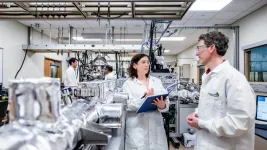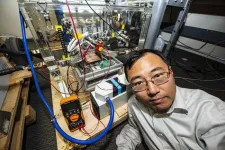(Press-News.org) Center to develop cost-effective method for decarbonized manufacturing for steelmaking without a blast furnace.
Steel has a major impact on everyone’s lives and our economy. It is crucial to cars, trucks, airplanes, buildings and more. However, there is a significant issue with its production process. Globally, it accounts for a large percentage of greenhouse gas emissions from the industrial sector.
The U.S. Department of Energy (DOE) recently announced $19 million in funding over four years for DOE’s Argonne National Laboratory to lead the multi-institutional Center for Steel Electrification by Electrosynthesis (C-STEEL). The center’s charge is to develop an innovative and low-cost process that would replace blast furnaces in steelmaking and reduce greenhouse gas emissions by 85%.
“It’s a big target that has a high reward if successful,” said Brian Ingram, the C-STEEL director and an Argonne group leader and materials scientist.
C-STEEL is a key project of the DOE’s Industrial Heat Energy Earthshot initiative, which aims to significantly cut emissions from the energy-intensive process of industrial heating. Partners in the center include Oak Ridge National Laboratory, Case Western Reserve University, Northern Illinois University, Purdue University Northwest and the University of Illinois Chicago.
“While current steelmaking requires intense heat from blast furnaces, our electrodeposition process will need low or even no heat input at all.” — Brian Ingram, C-STEEL director and an Argonne group leader and materials scientist
The most energy-intensive step in steel production involves converting iron ore into purified iron metal or iron alloys using blast furnaces. This demands temperatures of 2500 to 2700 degrees Fahrenheit, hotter than an erupting volcano. The center’s target is to develop a process that will essentially eliminate that heat demand, achieving an 85% reduction in greenhouse gas emissions by 2035.
“While current steelmaking requires intense heat from blast furnaces, our electrodeposition process will need low or even no heat input at all,” Ingram said. “It will also be cost efficient and adaptable to industrial-scale operations.”
The electrodeposition process involves dissolving iron ore in a solution and using electricity to initiate a reaction that deposits a useable iron metal or alloy for steelmaking. The solution is a liquid electrolyte similar to those found in batteries.
“We will be building upon the immense knowledge base we gained about different battery electrolytes from the work done by the Joint Center for Energy Storage Research, led by Argonne,” Ingram said.
The project has three thrusts. Two of them will investigate different processes for electrodeposition. One process will operate at room temperature using water-based electrolytes. The other will use a salt-based electrolyte and will function at temperatures 1800 to 2000 degrees Fahrenheit below current blast furnaces. The energy for this process is low enough that it could be provided by renewables or waste heat from a nuclear reactor.
A third thrust will focus on gaining an atomic-level understanding of each process. The goal of this thrust is to exert precise control over both the structure and composition of the metal products so that they can be incorporated into existing downstream processes of steelmaking.
Each thrust will incorporate an artificial intelligence-based platform to ensure a unified approach to electrolyte design. To that end, C-STEEL will be drawing upon the world-class computational resources of two Leadership Computing Facilities, one at Argonne and the other at Oak Ridge. Both are DOE Office of Science user facilities.
C-STEEL will also take advantage of the materials characterization capabilities of two other DOE user facilities at Argonne, the Advanced Photon Source and the Center for Nanoscale Materials.
“Another key part of the center is that one of the partner universities is a minority-serving institution, the University of Illinois Chicago,” said Ingram. “Through their participation and other actions, we will be forming a diverse team to contribute to our research efforts.” C-STEEL also plans to implement outreach initiatives, mentorship programs and career development opportunities for students and postdocs to excite the next generation of scientists.
This research is being funded by the DOE Office of Basic Energy Sciences and the DOE Advanced Scientific Computing Research program.
About Argonne’s Center for Nanoscale Materials
The Center for Nanoscale Materials is one of the five DOE Nanoscale Science Research Centers, premier national user facilities for interdisciplinary research at the nanoscale supported by the DOE Office of Science. Together the NSRCs comprise a suite of complementary facilities that provide researchers with state-of-the-art capabilities to fabricate, process, characterize and model nanoscale materials, and constitute the largest infrastructure investment of the National Nanotechnology Initiative. The NSRCs are located at DOE’s Argonne, Brookhaven, Lawrence Berkeley, Oak Ridge, Sandia and Los Alamos National Laboratories. For more information about the DOE NSRCs, please visit https://science.osti.gov/User-Facilities/User-Facilities-at-a-Glance.
The Argonne Leadership Computing Facility provides supercomputing capabilities to the scientific and engineering community to advance fundamental discovery and understanding in a broad range of disciplines. Supported by the U.S. Department of Energy’s (DOE’s) Office of Science, Advanced Scientific Computing Research (ASCR) program, the ALCF is one of two DOE Leadership Computing Facilities in the nation dedicated to open science.
About the Advanced Photon Source
The U. S. Department of Energy Office of Science’s Advanced Photon Source (APS) at Argonne National Laboratory is one of the world’s most productive X-ray light source facilities. The APS provides high-brightness X-ray beams to a diverse community of researchers in materials science, chemistry, condensed matter physics, the life and environmental sciences, and applied research. These X-rays are ideally suited for explorations of materials and biological structures; elemental distribution; chemical, magnetic, electronic states; and a wide range of technologically important engineering systems from batteries to fuel injector sprays, all of which are the foundations of our nation’s economic, technological, and physical well-being. Each year, more than 5,000 researchers use the APS to produce over 2,000 publications detailing impactful discoveries, and solve more vital biological protein structures than users of any other X-ray light source research facility. APS scientists and engineers innovate technology that is at the heart of advancing accelerator and light-source operations. This includes the insertion devices that produce extreme-brightness X-rays prized by researchers, lenses that focus the X-rays down to a few nanometers, instrumentation that maximizes the way the X-rays interact with samples being studied, and software that gathers and manages the massive quantity of data resulting from discovery research at the APS.
This research used resources of the Advanced Photon Source, a U.S. DOE Office of Science User Facility operated for the DOE Office of Science by Argonne National Laboratory under Contract No. DE-AC02-06CH11357.
Argonne National Laboratory seeks solutions to pressing national problems in science and technology. The nation’s first national laboratory, Argonne conducts leading-edge basic and applied scientific research in virtually every scientific discipline. Argonne researchers work closely with researchers from hundreds of companies, universities, and federal, state and municipal agencies to help them solve their specific problems, advance America’s scientific leadership and prepare the nation for a better future. With employees from more than 60 nations, Argonne is managed by UChicago Argonne, LLC for the U.S. Department of Energy’s Office of Science.
The U.S. Department of Energy’s Office of Science is the single largest supporter of basic research in the physical sciences in the United States and is working to address some of the most pressing challenges of our time. For more information, visit https://energy.gov/science.
END
Department of Energy funds new center for decarbonization of steelmaking
Reimagining the steel production process
2023-09-29
ELSE PRESS RELEASES FROM THIS DATE:
New criteria to assess progression in glioma aims to speed discovery of new medicines
2023-09-29
Study Title: RANO 2.0: Update to the Response Assessment in Neuro-Oncology Criteria for High- and Low-Grade Gliomas in Adults
Publication: Journal of Clinical Oncology
Dana-Farber Cancer Institute author: Patrick Y. Wen, MD
Summary: In order to accurately assess the efficacy of novel therapies for brain tumors it is necessary to have reliable criteria to determine response or progression. Response assessment in brain tumors is difficult because of the irregular shapes of the tumors and the fact that many therapies used to treat these tumors can also produce imaging changes that resemble tumor ...
NPS team makes key breakthrough on path to electric aircraft propulsion
2023-09-29
As an institution renowned for innovation efforts grounded in education and research, the Naval Postgraduate School (NPS) has often been called upon to tackle some of the most difficult technological challenges facing the Navy and the nation.
Such a challenge emerged in 2020, when NASA charged NPS and two other research teams with solving a critical barrier facing the development of electric aircraft propulsion (EAP): the creation of a circuit breaker that could support large electric platforms running on direct current (DC) electricity. Thanks to the efforts of a diverse team of faculty and students, as well as several Navy and academic research partners, NPS delivered ...
Berkeley Lab awarded two new centers to counter climate change
2023-09-29
The Department of Energy’s Lawrence Berkeley National Laboratory (Berkeley Lab) will host two new centers dedicated to advancing clean energy technology and combating climate change. The awards are part of DOE’s Energy Earthshots Initiative that launched in 2021 with the goal of speeding up technological breakthroughs and lowering costs.
DOE has so far launched seven Earthshots spanning clean energy and carbon reduction technologies. The Berkeley Lab programs announced today will address two of them: the Hydrogen ...
Stanford researchers unveil new material infused with gold in an exotic chemical state
2023-09-29
For the first time, Stanford researchers have found a way to create and stabilize an extremely rare form of gold that has lost two negatively charged electrons, denoted Au2+. The material stabilizing this elusive version of the valued element is a halide perovskite—a class of crystalline materials that holds great promise for various applications including more-efficient solar cells, light sources, and electronics components.
Surprisingly, the Au2+ perovskite is also quick and simple to make using off-the-shelf ingredients at room temperature.
"It was a real surprise that we were able to synthesize a stable material containing Au2+—I didn't even believe it at ...
Research Highlights for September 2023
2023-09-29
Huntsman Cancer Institute shines the spotlight on new discoveries and cutting-edge cancer research. This month, researchers found that increasing access for Black people with prostate cancer may save lives. Also, the first patient in a new small cell lung cancer clinical trial has been enrolled, researchers are using an app to help adolescents and young adults manage cancer symptoms, and investigators are trying to reduce cognitive side-effects after chemotherapy.
Increasing access to Black people with prostate cancer may decrease mortality rate
In a study published ...
JMIR Publications places No, 348 on The Globe and Mail's annual ranking of Canada's Top Growing Companies
2023-09-29
(Toronto, September 29, 2023) JMIR Publications is pleased to announce it placed No. 348 on the 2023 Report on Business ranking of Canada’s Top Growing Companies, making the ranking over the past three consecutive years.
Canada’s Top Growing Companies ranks Canadian companies on three-year revenue growth. JMIR Publications earned its spot with three-year growth of 105%.
“Being ranked on this list, year over year, showcases JMIR Publications’ national and global leadership in publishing high-quality open access ...
Argonne National Laboratory launches South Side STEM Opportunity Landscape Project at DuSable Black History Museum and Education Center
2023-09-29
A transformative initiative aimed at identifying, enhancing and promoting science, technology, engineering and mathematics resources within local communities.
The U.S. Department of Energy’s Argonne National Laboratory is proud to announce the official launch of the South Side STEM Opportunity Landscape Project, a transformative initiative aimed at identifying, enhancing and promoting science, technology, engineering and mathematics (STEM) resources within local communities.
As part of the Argonne in Chicago initiative that includes offices in Hyde Park, the ...
Allergy study on 'wild' mice challenges the hygiene hypothesis
2023-09-29
The notion that some level of microbial exposure might reduce our risk of developing allergies has arisen over the last few decades and has been termed the hygiene hypothesis. Now, an article published in Science Immunology by researchers from Karolinska Institutet challenges this hypothesis by showing that mice with high infectious exposures from birth have the same, if not an even greater ability to develop allergic immune responses than 'clean' laboratory mice.
How microbes may prevent allergy has been a topic of great interest in recent times. Studies have suggested that certain infections might reduce the production of inflammatory antibodies to ...
Ancient plant wax reveals how global warming affects methane in Arctic lakes
2023-09-29
New study makes novel use of plant biomarkers preserved in sediment to reconstruct methane cycling over the past 10,000 years
Plant waxes hold an isotopic signature of ancient methane
As planet warmed due to slow changes in Earth’s orbit, lakes produced increased amounts of methane, which is a potent greenhouse gas
Researcher: ‘Living on a warming planet, we can look to these signs from the past to predict our future’
EVANSTON, Ill. — By studying fossils from ancient aquatic plants, ...
Atopic dermatitis: Viruses discovered as new therapy option
2023-09-29
Up to 15 percent of children and five percent of adults are affected by the chronic inflammatory skin disease atopic dermatitis. Despite advanced therapy measures, the severe itching and eczema, especially on the elbows or knees, cause great distress to the patients. In the course of a study conducted at MedUni Wien a research team led by Wolfgang Weninger, Head of the Department of Dermatology, has discovered a new approach: bacteriophages, which colonize the skin as viral components of the microbiome and can drive the development of innovative ...
LAST 30 PRESS RELEASES:
Deep neural networks enable accurate pricing of American options under stochastic volatility
Collective risk resonance in Chinese stock sectors uncovered through higher-order network analysis
Does CPU impact systemic risk contributions of Chinese sectors? Evidence from mixed frequency methods with asymmetric tail long memory
General intelligence framework to predict virus adaptation based on a genome language model
Antibiotic resistance is ancient, ecological, and deeply connected to human activity, new review shows
Vapes, pouches, heated tobacco, shisha, cigarettes: nicotine in all forms is toxic to the heart and blood vessels
From powder to planet: University of Modena engineers forge a low-carbon future for advanced metal manufacturing
Super strain-resistant superconductors
Pre-school health programme does not improve children’s diet or physical activity, prompting call for policy changes, study finds
Autumn clock change linked to reduction in certain health conditions
AI images of doctors can exaggerate and reinforce existing stereotypes
Where medicine meets melody – how lullabies help babies and parents in intensive care
We may never be able to tell if AI becomes conscious, argues philosopher
AI video translation shows promise but humans still hold the edge
Deep ocean earthquakes drive Southern Ocean’s massive phytoplankton blooms, study finds
Without campus leftovers to pick through, the beaks of this bird changed shape during the pandemic
High-dose antibiotic does not reduce mortality in tuberculous meningitis
How many insects fly in the sky above the USA?
Could cheese protect your brain health?
Who faces more difficulty recovering from stroke?
Colliding galaxies create the brightest, fastest growing black holes at their center
New BrainHealth research reveals tradeoffs on sleep with cannabis use for chronic pain
Aging-US now on ResearchGate, enhancing visibility for authors and readers
'Molecular glue' stabilizes protein that inhibits development of non-small cell lung cancer
Mount Sinai Health System is recognized in 2025 Chime Digital Health Most Wired survey
From prey to predator: How carnivores spread beneficial fungi
Menopause symptoms may be frequent and have negative effects, according to female endurance athletes
US Congressmembers’ responses on X to mass shooting events differ along party lines
KAIST-UEL team develops “origami” airless wheel to explore lunar caves
Individual genetic differences render some therapies ineffective
[Press-News.org] Department of Energy funds new center for decarbonization of steelmakingReimagining the steel production process







